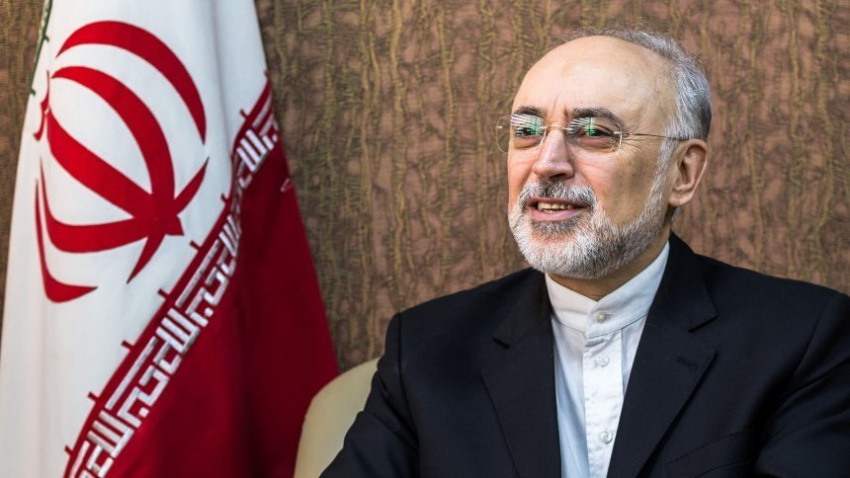Nuclear chief: Centrifuge is one of tools needed to make COVID-19 vaccine

Iran marked National Nuclear Technology Day on Saturday during which the Atomic Energy Organization of Iran (AEOI) unveiled a number of new progresses in nuclear industry. President Hassan Rouhani inspected a number of new machineries and equipment used in nuclear industry.
“A large part of 133 achievements that the president talked about today is about nuclear fuel. More than 50% of nuclear achievements relates to agriculture, among other fields,” Salehi said.
He clarified with an example about nuclear radiation in agriculture, saying, “It can be referred to the rice that has recently been provided to farmers. This rice has high yield and acceptable resistance to drought. Or we can name the radiation systems as other types of nuclear achievements related to agriculture. Radiation systems that can be used to sterilize and extend the life of agricultural products. Radiation can prevent dates from rotting for several months.”
He also pointed to the existence of a special centrifuge in the blood bank of the health sector, saying, "This centrifuge was previously supposed to be imported from Germany, but after passing many tests, our centrifuge managed to enter the country's blood bank."
Salehi described centrifuges as one of the requirements for making the COVID-19 vaccine, and the Atomic Energy Organization, through one of its companies, was able to provide the desired centrifuge for the Barekat Pharmaceutical Company.
Barekat Pharmaceutical Company is working on COVID-19 vaccine. Its vaccines are going to be administered by mid-June.
Salehi, a nuclear physicist, also pointed to the production of titanium used in medical science for the first time in the country.
“In the field of radiopharmaceuticals, good accomplishments have been achieved so that the number of these radiopharmaceuticals is increasing every year. If we have to import it from abroad, we have to pay 15,000 Euros for each dose. This radiopharmaceutical has had positive responses in the treatment of prostate.”
He also pointed out that the Tetra project is underway in Iran.
“In this project, about 60 million Euros worth of equipment has been purchased for the production of radiopharmaceuticals. The production of these radiopharmaceuticals is done as standard or GMP. The project building is as big as 37,000 meters, which is being completed, and the first phase of this project will probably be launched in September. This project is unique in West Asia. Iran currently exports radiopharmaceuticals to many countries, including India, Pakistan, Iraq and Syria, and some European countries.”
He went on to say after the completion of the Tetra project in September, Iran will be the “largest exporter of radiopharmaceuticals in the world.”
The nuclear chief said that "ion therapy" is the latest method for treating a large number of cancers.
“We are the first in West Asia,” he said.
The AEOI chief elaborated on the progresses Iran has made throughout the years in nuclear science industry, stating, “We currently have software with which we design centrifuges of about 500,000 lines. We now have the ability to design centrifuges with different capacities, but this does not mean that these designs will work immediately. It will take about 15 years, because in Europe there is a French company responsible for setting up and operating centrifuges, and they do that in 10 years of time.”
The nuclear chief went on to discuss the latest accomplishments in the field of centrifuges.
“To date, we have about 15 types of centrifuges; IRS, IR9, IR8. As new centrifuges, IR5 and IR6 are among them. The complete IR6 chain was launched today (Saturday), while it should have been launched in the next eight years, but now the chain is on the verge of industrialization, although according to the law passed by the parliament, we have to launch 1000 IR6 centrifuges and install them within a year,” he said.
Salehi added, “In this regard, 164 centrifuges were launched and unveiled today, two waterfalls will be launched in Fordow soon, and IR6 waterfalls will be launched in Natanz.”
On the explosion of centrifuge assembly hall 10 months ago which the AEOI said was a sabotage act, Salehi said, "We did not stop and today we were able to temporarily set up a replacement hall for the exploded hall. We are currently working day and night to build all of our assembly halls in the heart of the mountains around Natanz ourselves. We hope that next year, these halls in the heart of the mountain will be ready and the facilities will be moved there.”
Iran’s next calendar year will start on March 21, 2022.
On 2 July 2020, an explosion hit a centrifuge assembly facility in the Natanz nuclear facility. Israel is being seen as the main suspect for the vicious act.
Source: Tehran Times

